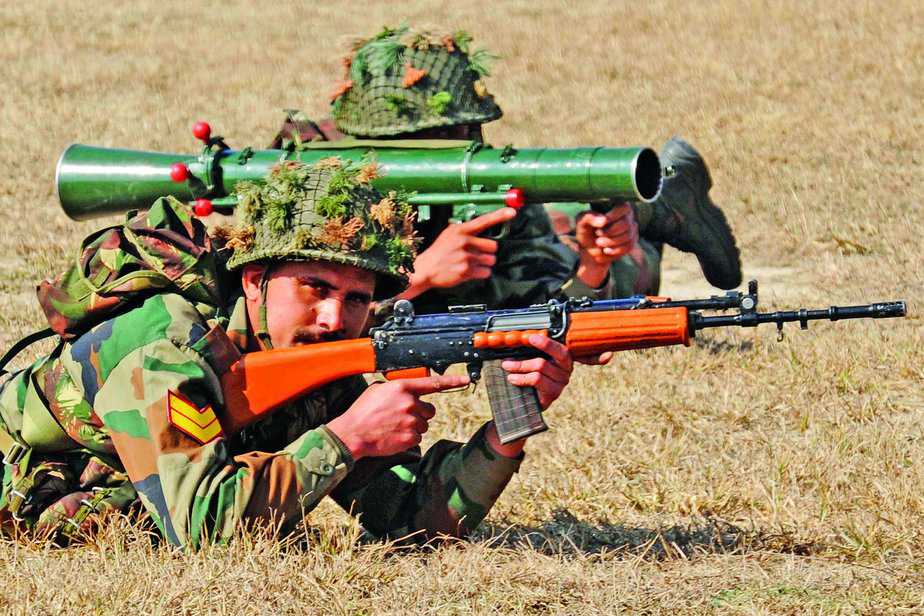
NOTHING NEW: Lt Gen Sarath Chand emphatically stated there was no money for modernisation of the armed forces Photo: AFP/ ILLUSTRATION: ANISH DAOLAGUPU
In 2010, Stephen P Cohen and Sunil Dasgupta wrote the bestseller, Arming Without Aiming. They argued that India had the ambition to become a great power. Consequently, the country was motivated to reform and modernise its armed forces. An economy growing at 7-8 per cent would make the resources available after all. But India lacked a security strategy and, hence, a rudder for its military modernisation. The end result was: arming without aiming.
All this was well known to military analysts. In addition, it was also well known that the military itself was obsessed with structural and organisational status quo as it resisted reform. We were, and are, fighting a fourth-generation war, training and preparing for a third-generation war, and have a mindset, structures and organisations for a second-generation war.
But there was eternal hope that, so long as money was made available and we modernised our armed forces, we would adjust and adapt to the security needs of the future. The approach was and remains ‘bottom up’ with the military presenting idealistic requirements to the government and the latter reluctantly parting with resources. The omnipresent and recurring corruption scandals did slow down the process but still, steady progress was made.
With the coming in of the new government, led by a party ideologically committed to making India a great power and, by implication, reforming and modernising the armed forces, hopes were raised sky high. A muscular policy was adopted to deal with internal and external security issues. The move received overwhelming public support. There was a marked change in our approach to handling insurgencies, Pakistan’s proxy war and China’s salami slicing. Despite the musical chairs in respect of the Defence Minister’s appointment, the nation anxiously waited for the National Security Strategy, Force Development Strategy and urgent reforms. It was left to the Vice Chief of Army Staff to innocently admit the emperor had no clothes on.
On March 13, 2018, briefing the parliamentary committee for defence, Lt Gen Sarath Chand emphatically stated that the there was no money for modernisation of the armed forces and, with the current allocation, only status quo could be maintained.
The VCOAS carefully chose his words and his deposition was blunt to a fault, highlighting the state of our national security and the yawning gap between political pronouncements and their execution.
He lauded the new procurement policy, the delegation of powers for emergency procurement and for making up the shortages for 10 days of intense fighting. Then he let the cat out of the bag, by stating, “However, the Budget of 2018-19 has dashed our hopes and most of what has been achieved has actually received a setback…the marginal increase in BE [Budget estimates] barely accounts for inflation and does not cater for the taxes.”
Talking about the allocation of funds for modernisation he said, “Allocation of ₹21,338 crore for modernisation is insufficient even to cater for committed payments of ₹29,0338 crore for 125 ongoing schemes, emergency procurements, 10 (I) and other DGOF requirements. Committed liabilities of 2017 which will get passed on to 2018 will further accentuate the situation. Therefore, liquidation of this committed liability will hardly leave any funds for new schemes in 2018-19.”
He then lamented about the current state of the army by highlighting that, typically, any modern armed forces should have one-third of its equipment in the vintage category, one-third in the current category and one-third in the state-of-the-art category. “As far as we are concerned, the state today is (such) that 68 per cent of our equipment is in the vintage category, with just 24 per cent in the current category, and 8 per cent in the state-of-the-art category.”
In a tongue-in-cheek statement on the Make in India programme, he said, “Make in India as mentioned in the morning is a great step taken by the Ministry of Defence towards development and self-reliance in keeping with the vision of our Honourable Prime Minister. A large number of systemic changes outlined in the defence procurement procedure of 2016 were aimed at this to achieve greater indigenisation. We in the army have identified as many as 25 projects for Make in India. However, there is not adequate budget to support this. As a result of which, many
Police said despite sustained efforts, the accused remained at large and kept changing locations and…
At a debut solo exhibition in Delhi, an architect-artist explores sand, memory and movement through…
Om Taneja (81) and his wife Indira (77), a doctor, were kept under “digital arrest”…
The court observed although appellant had caused death by rash and negligent act, sending him…
AAP leaders were detained during a protest against the BJP over an alleged doctored video…
NDMC is rolling out a G20-style upgrade of roads, lighting and cleanliness to prepare Delhi…